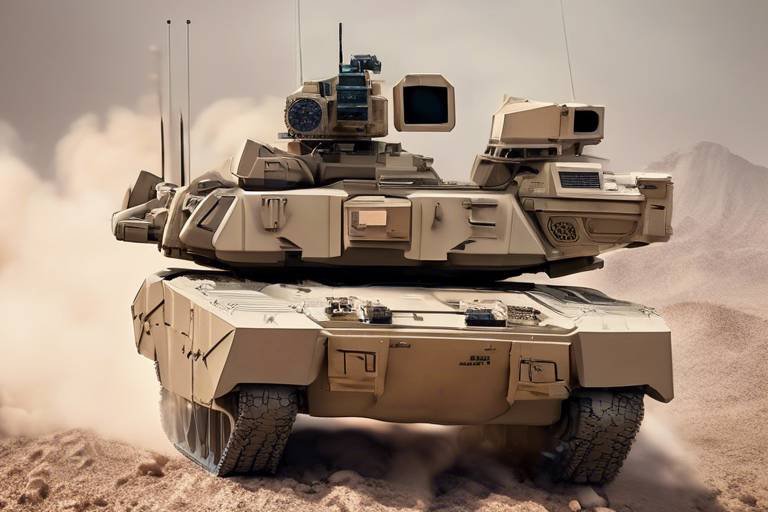Evaluating the Effectiveness of Integrated Defense Systems
In an era where global threats are evolving at an unprecedented pace, the significance of integrated defense systems cannot be overstated. These systems are not merely a collection of weapons and technologies; they represent a comprehensive strategy that interlinks various military capabilities to create a robust defense mechanism for nations. By assessing their efficiency, challenges, and overall impact on national security, we can better understand how these systems function and their importance in safeguarding our future.
At its core, an integrated defense system is designed to enhance interoperability among various military branches, ensuring that air, land, and sea forces can work seamlessly together. This integration is crucial because modern warfare is not confined to one domain; threats can emerge from the sky, the sea, or even cyberspace. By creating a cohesive defense strategy, nations can respond more effectively to these multifaceted challenges.
However, evaluating the effectiveness of these systems is no small feat. It requires a thorough analysis of various components, including technological advancements, strategic planning, and real-world applications. For instance, how do we measure the success of a missile defense system? Is it based solely on the number of intercepted threats, or does it also take into account the system's ability to adapt to new technologies and tactics used by adversaries? These questions are essential in understanding the true effectiveness of integrated defense systems.
Moreover, integrated defense systems must navigate a complex landscape of challenges. Budget constraints can limit the development and deployment of advanced technologies, while political factors can hinder inter-service cooperation. The effectiveness of these systems can also be impacted by the rapid pace of technological change, as outdated systems may struggle to keep up with emerging threats.
In summary, evaluating the effectiveness of integrated defense systems involves a multifaceted approach that considers not only the technologies involved but also the broader strategic context. As we delve deeper into this topic, we will explore the historical evolution of defense systems, the technological advancements that have shaped them, and the challenges faced in their implementation. By doing so, we can gain a clearer picture of how integrated defense systems are transforming national security in today's world.
- What are integrated defense systems?
Integrated defense systems are comprehensive military strategies that combine various defense capabilities across different domains, such as air, land, and sea, to create a cohesive defense mechanism. - Why are integrated defense systems important?
These systems enhance interoperability among military branches, allowing for a more effective response to diverse and evolving threats. - What challenges do integrated defense systems face?
Common challenges include budget constraints, political factors, and the need for inter-service coordination. - How do technological advancements impact integrated defense systems?
Technological innovations can significantly enhance the capabilities of integrated defense systems, making them more effective in countering modern threats.

Understanding Integrated Defense Systems
Integrated defense systems are the backbone of modern military strategy, designed to provide a comprehensive and coordinated approach to national security. But what exactly are they? At their core, integrated defense systems combine various military assets and technologies to create a unified defense strategy that can respond effectively to a range of threats. These systems are not just a collection of weapons; they are a sophisticated network of sensors, command and control centers, and response units that work together seamlessly.
Think of integrated defense systems as a symphony orchestra, where each instrument plays a vital role in creating a harmonious sound. In this analogy, the conductor represents the command and control systems, ensuring that each component—be it air, land, or sea forces—plays its part at the right time. This orchestration is crucial, as it allows for real-time data sharing and strategic decision-making, enabling forces to respond to threats with agility and precision.
The key components of integrated defense systems include:
- Sensors: These are the eyes and ears of the defense network, including radar systems, satellites, and reconnaissance drones that gather intelligence on potential threats.
- Command and Control Centers: These serve as the brains of the operation, processing data from sensors and coordinating responses across different military branches.
- Response Units: This includes various military assets, such as fighter jets, naval vessels, and ground troops, ready to engage in defense operations when necessary.
One of the most significant advantages of integrated defense systems is their ability to provide a layered defense strategy. This means that multiple layers of defense can be employed to protect against different types of threats, be they aerial attacks, cyber intrusions, or ground incursions. Each layer acts as a safety net, ensuring that if one fails, others are in place to mitigate the risk. For instance, if an enemy missile manages to penetrate initial defenses, subsequent layers, such as missile interceptors, are ready to take action.
Moreover, the integration of advanced technologies, including artificial intelligence and machine learning, enhances the effectiveness of these systems. AI algorithms can analyze vast amounts of data at lightning speed, identifying patterns and predicting potential threats before they materialize. This proactive approach not only improves situational awareness but also allows for quicker and more informed decision-making, which is crucial in high-stakes scenarios.
In summary, integrated defense systems are a multifaceted approach to national security, combining various military technologies and strategies to create a cohesive defense network. Their ability to adapt to evolving threats and coordinate responses across different military branches makes them indispensable in today's complex security environment. As we delve deeper into the historical context and technological advancements that have shaped these systems, it becomes clear that understanding their structure and function is vital for appreciating their role in safeguarding nations.
Q1: What is the primary goal of integrated defense systems?
A1: The primary goal of integrated defense systems is to provide a coordinated and efficient response to various security threats, ensuring national safety through a comprehensive network of military assets and technologies.
Q2: How do integrated defense systems improve decision-making?
A2: They enhance decision-making by utilizing advanced technologies like artificial intelligence to analyze real-time data, enabling quicker responses to threats and better situational awareness.
Q3: What are some challenges faced in implementing integrated defense systems?
A3: Common challenges include budget constraints, political factors, and the need for inter-service coordination among different military branches.

Historical Context of Defense Systems
The evolution of defense systems is a fascinating journey that reflects the changing dynamics of warfare and national security. From the rudimentary fortifications of ancient civilizations to the sophisticated integrated defense systems of today, history has shown that the effectiveness of military strategies is often dictated by technological advancements and the geopolitical landscape. In the early days, defense mechanisms were primarily physical barriers—think walls, moats, and watchtowers. These structures served as the first line of defense against invading forces, but as conflicts grew in scale and complexity, so did the need for more advanced systems.
Fast forward to the 20th century, where the world witnessed two devastating World Wars that significantly reshaped military strategies. The introduction of aerial combat changed the game entirely. As nations began to realize the importance of air superiority, integrated defense systems started to take shape. These systems combined various elements—land, air, and sea forces—to create a unified approach to national defense. The Cold War era further propelled this evolution, as countries invested heavily in technology to protect against potential nuclear threats. The arms race led to innovations such as radar systems, missile technology, and early warning systems, laying the groundwork for what we now recognize as integrated defense systems.
One of the most significant milestones in this evolution was the development of missile defense systems during the late 20th century. Countries like the United States and Russia began to deploy systems designed to intercept and destroy incoming missiles, marking a shift from purely offensive strategies to a more defensive posture. This was a game-changer, as it introduced the concept of layered defense, where multiple systems work together to protect against various threats.
As we moved into the 21st century, the landscape of warfare continued to evolve. The rise of cyber warfare introduced a new dimension to national security, necessitating the integration of cyber defense into traditional military frameworks. Today, integrated defense systems are not just about intercepting missiles or detecting aircraft; they encompass a wide array of technologies, including artificial intelligence, data analytics, and cyber capabilities. This transformation reflects a broader understanding of modern threats, which are often multifaceted and require a coordinated response.
In summary, the historical context of defense systems is marked by continuous adaptation to technological advancements and shifting geopolitical realities. As nations strive to protect their interests, the integration of various defense components has become crucial. This historical perspective not only highlights the achievements of past military strategies but also underscores the challenges that lie ahead in the realm of national security.
- What are integrated defense systems?
Integrated defense systems are comprehensive military strategies that combine various defense components—such as air, land, and naval forces—into a cohesive framework designed to protect national security. - How have defense systems evolved over time?
The evolution of defense systems has been influenced by historical conflicts, technological advancements, and changing geopolitical landscapes, leading to more sophisticated and integrated approaches to national defense. - What role does technology play in modern defense systems?
Technology is crucial in modern defense systems, enabling advancements in areas like radar, missile defense, artificial intelligence, and cybersecurity, which enhance overall military effectiveness.

Key Technological Advancements
In the realm of integrated defense systems, technological advancements have played a pivotal role in shaping the efficiency and effectiveness of military strategies. These systems are no longer just about having a strong army; they are about integrating various technologies to create a cohesive defense strategy that can respond to a multitude of threats. At the heart of this transformation are several key innovations that have revolutionized how nations protect themselves.
One of the most significant advancements is in radar technology. Modern radar systems have evolved from simple detection tools to sophisticated platforms capable of tracking multiple targets simultaneously, even in challenging environments. This leap in capability allows for real-time situational awareness, enabling defense forces to react swiftly to potential threats. For instance, phased array radar systems can electronically steer beams, providing enhanced tracking accuracy and reducing the time needed to identify incoming threats.
Another breakthrough is in missile defense systems. The development of systems like the Aegis Ballistic Missile Defense and the Terminal High Altitude Area Defense (THAAD) has significantly bolstered national security. These systems utilize advanced tracking and interception technologies to neutralize ballistic missiles before they can reach their targets. The integration of satellite data with ground-based systems ensures a comprehensive defensive umbrella, enhancing the likelihood of successful interceptions.
Cyber warfare technologies have also emerged as a crucial component of integrated defense systems. In an age where information is power, the ability to protect critical infrastructure from cyber threats is paramount. Nations are investing heavily in cyber capabilities, developing advanced software and protocols to safeguard their networks. This includes everything from robust firewalls to sophisticated intrusion detection systems that can identify and mitigate threats in real-time.
Furthermore, the integration of artificial intelligence (AI) into defense systems is transforming how military operations are conducted. AI can analyze vast amounts of data far more quickly than any human could, providing decision-makers with actionable insights that can enhance operational efficiency. Imagine a battlefield where AI systems can predict enemy movements or optimize resource allocation on the fly; this is no longer a distant dream but a reality that many militaries are beginning to embrace.
The application of AI extends beyond mere data analysis. It also plays a role in autonomous systems, such as drones and unmanned vehicles, which are becoming increasingly prevalent in modern warfare. These systems can perform reconnaissance, surveillance, and even combat missions without risking human lives. The ability to deploy unmanned systems in hostile environments not only enhances operational capabilities but also reduces the risk to personnel, making them invaluable assets in integrated defense strategies.
In conclusion, the landscape of integrated defense systems is being reshaped by these key technological advancements. From radar and missile defense systems to the integration of AI and cyber technologies, the evolution of these tools reflects a broader trend towards more sophisticated, responsive, and interconnected military capabilities. As nations continue to invest in these advancements, the future of national security will undoubtedly be influenced by how effectively these technologies are integrated and utilized.
- What are integrated defense systems? Integrated defense systems combine multiple defense technologies and strategies to create a cohesive security framework that can address various threats.
- How has radar technology improved? Modern radar systems can track multiple targets simultaneously and offer real-time situational awareness, enhancing defensive capabilities.
- What role does AI play in defense? AI enhances decision-making processes, optimizes operations, and enables the use of autonomous systems in military applications.
- Why is cybersecurity important in defense systems? Cybersecurity protects critical infrastructure from digital threats, ensuring that defense systems remain operational and secure against attacks.

Impact of Artificial Intelligence
Artificial Intelligence (AI) is revolutionizing the landscape of integrated defense systems, much like how the invention of the wheel transformed transportation. Imagine a world where machines can analyze vast amounts of data in seconds, making crucial decisions that once took humans hours or even days. This is not science fiction; it's the reality of modern military operations. AI enhances the efficiency and effectiveness of integrated defense systems in several key ways.
First and foremost, AI significantly improves decision-making processes. In the heat of battle, commanders need to make split-second decisions that could mean the difference between victory and defeat. AI algorithms can process real-time data from various sources—such as satellites, drones, and ground sensors—allowing commanders to assess the battlefield landscape swiftly. With predictive analytics, AI can even forecast enemy movements, giving military leaders a strategic edge.
Moreover, AI is automating various defense operations, which reduces the burden on human personnel. For instance, drones powered by AI can conduct surveillance missions without direct human control, allowing operators to focus on more complex tasks. This automation also extends to maintenance and logistics, where AI can predict when equipment needs servicing, thus preventing costly downtime. Imagine a scenario where a military aircraft can diagnose its own issues and schedule repairs autonomously; this not only saves time but also enhances operational readiness.
However, the integration of AI into defense systems is not without its challenges. There are ethical considerations regarding the use of autonomous weapons systems, which raises questions about accountability and the potential for unintended consequences. If an AI-driven drone makes a mistake, who is responsible? These are critical issues that military strategists and policymakers must address as they navigate the complexities of AI in defense.
To illustrate the impact of AI in integrated defense systems, consider the following table that summarizes key applications:
| Application | Description | Benefits |
|---|---|---|
| Surveillance Drones | AI-powered drones that conduct reconnaissance missions. | Increased situational awareness and reduced risk to personnel. |
| Predictive Maintenance | AI systems that predict equipment failures before they happen. | Minimized downtime and cost-effective maintenance. |
| Cyber Defense | AI algorithms that detect and respond to cyber threats in real-time. | Enhanced security against cyber-attacks. |
In summary, the impact of artificial intelligence on integrated defense systems is profound. It not only enhances operational capabilities but also introduces new ethical dilemmas that must be carefully navigated. As we look to the future, the role of AI in defense will likely expand, creating both opportunities and challenges that military leaders must be prepared to face.
- What is the role of AI in integrated defense systems?
AI plays a crucial role in enhancing decision-making, automating operations, and improving predictive maintenance in defense systems. - Are there ethical concerns regarding AI in military applications?
Yes, the use of autonomous weapons and decision-making algorithms raises important ethical questions about accountability and the potential for unintended consequences. - How does AI improve decision-making in combat situations?
AI can analyze real-time data from multiple sources, allowing commanders to make informed decisions quickly and effectively. - What are some examples of AI applications in defense?
Examples include AI-powered surveillance drones, predictive maintenance systems, and advanced cyber defense algorithms.

Cybersecurity Considerations
In today's digital age, where information flows at lightning speed, the significance of cybersecurity within integrated defense systems cannot be overstated. As nations increasingly rely on technology to enhance their defense capabilities, they also become more vulnerable to cyber threats that can undermine their security. Imagine a well-coordinated military operation being jeopardized by a simple cyber attack; it's not just a possibility, it's a reality that defense strategists must grapple with.
Cybersecurity in integrated defense systems involves a multifaceted approach to protect sensitive data, communication networks, and operational technologies from malicious attacks. These systems are not just about physical weaponry; they encompass a vast array of interconnected technologies, making them prime targets for cyber adversaries. The implications of a successful breach can be catastrophic, leading to compromised missions, loss of classified information, and even endangering lives.
To effectively address these challenges, it is crucial to implement a robust cybersecurity framework that includes:
- Risk Assessment: Identifying potential vulnerabilities within the system is the first step in fortifying defenses. Regular audits and assessments can help pinpoint weak spots that need attention.
- Incident Response Plans: Preparing for the worst-case scenario is vital. An effective incident response plan ensures that, in the event of a breach, there are predefined steps to mitigate damage and restore operations swiftly.
- Continuous Monitoring: Cyber threats are constantly evolving, making it essential to have real-time monitoring systems in place. This proactive approach allows for swift detection and response to potential threats.
Moreover, collaboration between various defense sectors and private cybersecurity firms can enhance the overall security posture. Sharing intelligence about emerging threats and vulnerabilities can create a more resilient defense network. Just as a chain is only as strong as its weakest link, integrated defense systems must ensure that all components, including software and hardware, are fortified against cyber attacks.
Furthermore, the human element cannot be ignored. Training personnel to recognize phishing attempts and other social engineering tactics is just as important as technical defenses. After all, the most sophisticated systems can be compromised by a single click from an unsuspecting user. Therefore, fostering a culture of cybersecurity awareness is essential for the integrity of integrated defense systems.
As we look to the future, the integration of advanced technologies such as artificial intelligence and machine learning can significantly enhance cybersecurity efforts. These technologies can analyze vast amounts of data to identify patterns and anomalies that humans might overlook, thereby providing an additional layer of protection. However, this also raises concerns about the potential for AI-driven cyber attacks, necessitating a careful balance between leveraging technology and ensuring security.
In conclusion, the effectiveness of integrated defense systems is profoundly influenced by their cybersecurity measures. As threats continue to evolve, so too must the strategies to combat them. By prioritizing cybersecurity, nations can not only protect their military operations but also safeguard their national security in an increasingly interconnected world.
- What are integrated defense systems?
Integrated defense systems refer to a combination of various military assets and technologies that work together to provide comprehensive security solutions. - Why is cybersecurity important in defense systems?
Cybersecurity is crucial as it protects sensitive information and ensures the integrity of military operations against cyber threats. - How can organizations improve their cybersecurity posture?
Organizations can enhance their cybersecurity by conducting regular risk assessments, implementing incident response plans, and fostering a culture of cybersecurity awareness among personnel.

Challenges in Implementation
Implementing integrated defense systems is no walk in the park. In fact, it can often feel like trying to assemble a jigsaw puzzle with missing pieces. There are a myriad of challenges that nations face when they attempt to deploy these complex systems, which are designed to protect their sovereignty and ensure national security. One of the most significant hurdles is budget constraints. Defense budgets are often tight, and prioritizing spending on advanced technologies versus traditional military needs can lead to tough decisions. Governments must weigh the immediate needs against long-term investments, which can stall the development of integrated systems.
Moreover, political factors play a crucial role in the implementation of defense systems. Political will is necessary to push through the funding and support required for these systems. Changes in administration or shifts in public opinion can drastically alter the course of defense projects. For instance, a new government might prioritize different security threats, leading to potential disruptions in ongoing projects. This unpredictability can result in wasted resources and delayed timelines, causing frustration among defense contractors and military personnel alike.
Another significant challenge is the issue of inter-service coordination. Integrated defense systems often require collaboration among various branches of the military—air force, navy, and army. Each branch has its own culture, priorities, and operational procedures, which can create friction. Imagine trying to coordinate a dance performance with a group that has never rehearsed together. The result can be a chaotic and inefficient response to threats. Effective communication and a unified strategy are essential to overcome these hurdles, but achieving that level of coordination is easier said than done.
Furthermore, the rapid pace of technological advancement presents a double-edged sword. While new technologies can enhance defense capabilities, they also require constant updates and training. This leads to the challenge of keeping personnel trained and ready to utilize these systems effectively. With technology evolving at lightning speed, there is a risk that military personnel may find themselves operating outdated systems or lacking the skills needed to leverage the latest innovations.
Finally, the threat landscape itself is constantly changing. As nations develop new defense systems, adversaries are simultaneously working to counteract them, leading to an ongoing arms race. This reality raises the question: how can integrated defense systems remain effective when the threats they are designed to counter are always evolving? This necessitates a flexible approach to defense strategy, one that can adapt to new challenges as they arise.
In summary, the implementation of integrated defense systems is fraught with challenges that require careful navigation. From budgetary limitations and political dynamics to inter-service coordination and technological adaptation, each obstacle must be addressed with strategic foresight. Only then can nations hope to create robust defense systems that truly enhance their security.
- What are integrated defense systems? Integrated defense systems are comprehensive military frameworks that combine various defense technologies and strategies to provide a cohesive defense against threats.
- Why are budget constraints a challenge? Budget constraints limit the resources available for developing and maintaining advanced defense systems, forcing governments to make difficult choices about where to allocate funding.
- How does political change affect defense systems? Changes in government can lead to shifts in defense priorities, which may disrupt ongoing projects and affect funding and support for integrated defense initiatives.
- What role does technology play in defense systems? Technology enhances the capabilities of defense systems but also requires ongoing training and updates to ensure personnel can effectively utilize the latest advancements.
- How do countries adapt to changing threats? Countries must adopt flexible defense strategies that can evolve in response to new and emerging threats, ensuring their integrated systems remain effective.

Case Studies of Effective Defense Systems
When it comes to integrated defense systems, learning from real-world examples can provide invaluable insights. These case studies not only showcase the effectiveness of various systems but also highlight best practices that can be replicated elsewhere. Let's dive into a few notable examples that stand out in the realm of military defense.
One of the most acclaimed integrated defense systems is the Israeli Iron Dome. This system was designed to intercept and destroy short-range threats, such as rockets and artillery shells, aimed at populated areas. The Iron Dome has proven its worth in numerous conflicts, successfully intercepting over 90% of incoming threats. Its success can be attributed to its advanced radar and tracking technology, which allows for quick decision-making and accurate targeting. The system operates on a principle similar to that of a skilled archer aiming at a moving target, making split-second adjustments to ensure a successful hit.
Another noteworthy case is the United States Aegis Ballistic Missile Defense System. This naval-based system is designed to detect, track, and engage ballistic missiles. It employs a network of advanced radar systems and interceptor missiles, making it a formidable component of the U.S. Navy's defense strategy. Aegis has been tested in various scenarios, showcasing its ability to protect both ships and coastal installations from aerial threats. The system's integration with naval operations demonstrates how maritime forces can effectively collaborate with land and air forces to create a comprehensive defense network.
In Europe, the European Phased Adaptive Approach (EPAA) represents a collaborative effort among NATO allies to develop a missile defense system that protects against potential threats from the Middle East. This system utilizes a layered defense strategy, employing various components such as Aegis-equipped ships, land-based interceptors, and advanced radar systems. The EPAA highlights the importance of multinational cooperation in enhancing security, as member nations work together to share intelligence and resources. It's akin to a well-rehearsed orchestra, where each musician plays their part to create a harmonious defense.
To further illustrate the effectiveness of integrated defense systems, consider the following table that compares key features of these systems:
| Defense System | Country | Primary Function | Success Rate |
|---|---|---|---|
| Iron Dome | Israel | Short-range missile defense | 90%+ |
| Aegis | USA | Ballistic missile defense | High (exact rate classified) |
| EPAA | Europe (NATO) | Layered missile defense | In development |
These case studies not only highlight the technological advancements but also underscore the importance of strategy and collaboration in achieving successful defense outcomes. By analyzing these systems, military planners can glean lessons that inform future developments and enhance the overall effectiveness of integrated defense systems.
Q: What are integrated defense systems?
A: Integrated defense systems are comprehensive military frameworks that combine various defense technologies and strategies to protect against multiple threats, including missiles, aircraft, and cyber attacks.
Q: How do integrated defense systems improve national security?
A: By providing a layered defense approach, integrated systems enhance the ability to detect, track, and neutralize threats, thereby increasing the overall security posture of a nation.
Q: What role does technology play in integrated defense systems?
A: Technology is crucial, as advancements in radar, missile defense, and artificial intelligence significantly improve the capabilities and efficiency of integrated defense systems.
Q: Can integrated defense systems be adapted for different countries?
A: Yes, while the core principles remain the same, integrated defense systems can be tailored to meet the specific needs, threats, and operational contexts of different nations.

Comparative Analysis of Global Systems
The landscape of integrated defense systems is as diverse as the nations that employ them. Each country tailors its defense strategies based on its unique geopolitical situation, technological capabilities, and historical experiences. This comparative analysis delves into the strengths and weaknesses of various global systems, shedding light on how these nations adapt to evolving threats and challenges.
For instance, consider the United States, which boasts one of the most advanced integrated defense systems in the world. The U.S. employs a multi-layered approach that includes advanced missile defense systems like the Aegis Ballistic Missile Defense and THAAD (Terminal High Altitude Area Defense). This system not only focuses on intercepting incoming threats but also integrates seamlessly with cyber defense operations, enhancing situational awareness. However, this sophistication comes at a hefty price, often leading to budgetary constraints and political debates regarding defense spending.
In contrast, nations like Israel have developed their integrated defense systems in response to immediate regional threats. The Iron Dome, for example, is a testament to Israel's innovative approach, designed specifically to intercept short-range threats. Its success rate has garnered international attention, showcasing how a focused, responsive defense strategy can yield effective results. Yet, this system's reliance on continuous funding and technological support raises questions about sustainability in the long term.
Meanwhile, countries like Russia emphasize a different aspect of integrated defense. The S-400 missile system exemplifies Russia's strategy of combining advanced technology with robust military doctrine. This system allows for a multi-dimensional defense capability, integrating air defense with ground forces. However, the political landscape surrounding Russia's defense exports and the implications of such systems in global geopolitics often lead to tensions with other nations.
To further illustrate these differences, the table below summarizes key aspects of integrated defense systems from various countries:
| Country | Key System | Strengths | Challenges |
|---|---|---|---|
| United States | Aegis, THAAD | Advanced technology, multi-layered defense | High costs, budget constraints |
| Israel | Iron Dome | High success rate, rapid response | Sustainability, continuous funding |
| Russia | S-400 | Multi-dimensional capability, integration with ground forces | Political tensions, export implications |
Moreover, nations like China are rapidly advancing their integrated defense capabilities, focusing on both traditional and cyber warfare. The Chinese military has been integrating artificial intelligence into its defense systems, aiming to enhance decision-making and operational efficiency. However, the lack of transparency surrounding these developments raises concerns among other nations about the potential for aggressive posturing.
In summary, the comparative analysis of global integrated defense systems reveals a complex interplay of technology, strategy, and political considerations. Each nation's approach is influenced by its unique context, leading to a variety of systems that, while effective in their own right, also face distinct challenges. As threats evolve, so too will the strategies employed by these nations, making it crucial for observers to stay informed about global defense trends.
- What are integrated defense systems? Integrated defense systems combine various military capabilities and technologies to create a cohesive defense strategy against multiple threats.
- How do integrated defense systems differ between countries? Each country tailors its systems based on specific threats, technological capabilities, and political environments, leading to diverse approaches and implementations.
- What role does technology play in integrated defense systems? Technology is crucial in enhancing the effectiveness of defense systems, including advancements in radar, missile defense, and artificial intelligence.
- What challenges do countries face in implementing these systems? Common challenges include budget constraints, political factors, and the need for inter-service coordination.

Lessons Learned from Failures
In the complex world of integrated defense systems, failure is not just an option; it’s an opportunity to learn and grow. History has shown us that even the most robust systems can falter, and understanding these failures is crucial for future advancements. One of the most notable lessons learned is the importance of interoperability. When different branches of the military or allied nations cannot communicate effectively, the entire defense strategy can crumble like a house of cards. For instance, during the Gulf War, the lack of seamless communication between air and ground forces highlighted significant gaps, leading to operational inefficiencies.
Another key takeaway is the necessity of thorough testing and evaluation. Many integrated defense systems have been rushed into deployment without adequate testing, resulting in catastrophic failures. A prime example is the U.S. Army's Future Combat Systems, which faced numerous technical challenges and was ultimately deemed too ambitious and costly. This teaches us that no matter how advanced the technology, proper testing is essential to ensure reliability and effectiveness in real-world scenarios.
Moreover, we must address the issue of budget constraints. Many defense projects are susceptible to funding cuts, which can lead to compromised capabilities. The cancellation of the U.S. Navy's Zumwalt-class destroyer program serves as a stark reminder of how financial limitations can hinder technological progress. When budgets are slashed, critical components may be left out, resulting in systems that are not fully capable of meeting their intended objectives.
Additionally, political factors play a significant role in the success or failure of integrated defense systems. Political agendas can shift priorities, leading to inconsistent support for certain projects. For example, the cancellation of the U.S. Air Force's F-22 Raptor program was influenced by changing political landscapes, despite its advanced capabilities. This illustrates the need for a stable political commitment to defense initiatives to ensure their longevity and effectiveness.
Finally, the lessons learned from failures in integrated defense systems emphasize the importance of adaptability and continuous improvement. The battlefield is constantly evolving, and systems that fail to adapt risk becoming obsolete. The rise of cyber warfare is a prime example, where traditional defense strategies must be reassessed to combat new threats. As we move forward, it’s essential to foster a culture of innovation and learning within defense organizations, ensuring that they can respond to emerging challenges swiftly and effectively.
- What are integrated defense systems?
Integrated defense systems are comprehensive frameworks that combine various military assets and technologies to provide a coordinated defense strategy, enhancing national security. - What can we learn from failures in defense systems?
Failures often highlight the need for better interoperability, thorough testing, adequate funding, political stability, and adaptability to emerging threats. - How do budget constraints affect defense systems?
Budget cuts can lead to the cancellation or scaling back of critical projects, resulting in compromised capabilities and potential failures in defense strategies. - Why is adaptability important in defense systems?
The nature of warfare is constantly changing, and defense systems must evolve to address new challenges, such as cyber threats and advanced technologies.

Future Trends in Integrated Defense
As we look toward the horizon of national security, the future of integrated defense systems promises to be as dynamic as it is complex. In an era where threats are constantly evolving, the integration of cutting-edge technologies will play a pivotal role in shaping how nations protect their sovereignty. Imagine a world where artificial intelligence and machine learning are not just buzzwords, but integral components that enhance decision-making processes and streamline defense operations. This transformation is not merely theoretical; it is already in motion, and its implications are profound.
One of the most exciting trends on the battlefield of the future is the increasing reliance on autonomous systems. Drones and unmanned vehicles are set to revolutionize military tactics, enabling forces to conduct operations with greater precision and lower risk to human life. These systems can gather intelligence, perform surveillance, and even engage in combat without putting soldiers in harm's way. Imagine a scenario where a fleet of drones autonomously coordinates to neutralize a threat while minimizing collateral damage—this is not science fiction, but a glimpse into the future of warfare.
Moreover, the integration of cyber capabilities into defense systems cannot be overstated. As cyber threats become more sophisticated, the ability to defend against these attacks will be crucial. Future integrated defense systems will need to incorporate robust cybersecurity measures to protect sensitive data and operational integrity. This involves not only fortifying existing systems but also developing new protocols that can adapt to the rapidly changing landscape of cyber warfare. Countries that prioritize cyber resilience will find themselves better positioned to thwart attacks and safeguard their national interests.
Additionally, the role of big data analytics in defense will continue to expand. With the vast amounts of data generated by various defense systems, the ability to analyze and interpret this information in real-time will be a game changer. By leveraging advanced analytics, military leaders can make informed decisions swiftly, allowing for a more agile response to emerging threats. This capability will enhance situational awareness and improve operational effectiveness, creating a more responsive and adaptable defense posture.
However, as we embrace these advancements, we must also consider the ethical implications of integrating such technologies. Questions surrounding autonomy in warfare, the potential for AI to make life-and-death decisions, and the risks of cyber warfare must be addressed. Policymakers and military leaders need to engage in ongoing discussions about the rules of engagement in this new landscape, ensuring that technological advancements do not outpace our moral and ethical frameworks.
In summary, the future of integrated defense systems is poised to be shaped by a blend of technological innovation and strategic foresight. Countries that invest in autonomous systems, cyber capabilities, and data analytics will likely lead the charge in national security. Yet, as we advance, it is essential to navigate the accompanying challenges thoughtfully, ensuring that our approach to defense remains grounded in ethical considerations. The battlefield of the future will require not only advanced technology but also a commitment to responsible governance and international cooperation.
- What are integrated defense systems? Integrated defense systems are comprehensive frameworks that combine various military assets and technologies to enhance national security and operational effectiveness.
- How is artificial intelligence impacting defense? AI is transforming defense by improving decision-making processes, automating operations, and enhancing the capabilities of autonomous systems.
- What role does cybersecurity play in integrated defense? Cybersecurity is critical in protecting defense systems from cyber threats, ensuring the integrity and confidentiality of sensitive information.
- What are the ethical concerns surrounding autonomous systems? Ethical concerns include the potential for AI to make life-and-death decisions and the implications of using autonomous weapons in warfare.
Frequently Asked Questions
- What are integrated defense systems?
Integrated defense systems are comprehensive frameworks that combine various military assets and technologies to provide a unified defense strategy. They encompass everything from radar and missile defense systems to cyber warfare capabilities, all working together to protect national security.
- How have integrated defense systems evolved over time?
Over the decades, integrated defense systems have evolved significantly due to technological advancements and historical conflicts. Innovations in radar technology, missile defense systems, and artificial intelligence have reshaped how nations approach defense, making systems more efficient and responsive to threats.
- What role does artificial intelligence play in defense systems?
Artificial intelligence (AI) is revolutionizing integrated defense systems by enhancing decision-making processes and automating various operations. AI can analyze vast amounts of data in real time, allowing for quicker responses to threats and improving overall operational effectiveness.
- What are the main challenges in implementing integrated defense systems?
Implementing integrated defense systems often comes with challenges such as budget constraints, political factors, and the need for inter-service coordination. These obstacles can hinder the development and deployment of effective defense strategies, making it crucial for nations to navigate these issues carefully.
- Can you provide examples of successful integrated defense systems?
Yes! There are several successful integrated defense systems worldwide, such as Israel's Iron Dome and the United States' Aegis Ballistic Missile Defense System. These systems have demonstrated effectiveness in real-world scenarios, providing valuable lessons on best practices in defense integration.
- What are the future trends in integrated defense systems?
Future trends in integrated defense systems are likely to be shaped by emerging technologies such as advanced robotics, enhanced cybersecurity measures, and further integration of AI. As threats evolve, so too will the strategies and technologies used to counter them, ensuring that national security remains robust.



















